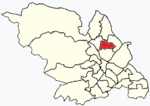Sheffield Brightside (UK Parliament constituency)

Sheffield, Brightside was a parliamentary constituency in the City of Sheffield. Created for the 1885 general election, and replaced at the 2010 general election by the new constituency of Sheffield Brightside and Hillsborough, it elected one Member of Parliament (MP) to the House of Commons of the Parliament of the United Kingdom, using the first-past-the-post voting system. In its first fifty years, Brightside returned a variety of Liberal, Conservative and Labour MPs. However, from 1945 onwards, it became one of the Labour Party's safest seats in the United Kingdom. It was represented by David Blunkett from 1987 until its abolition; he continued to hold the successor seat until he retired in 2015, becoming the seat's longest-serving MP.
Excerpt from the Wikipedia article Sheffield Brightside (UK Parliament constituency) (License: CC BY-SA 3.0, Authors, Images).Sheffield Brightside (UK Parliament constituency)
Lloyd Street, Sheffield Page Hall
Geographical coordinates (GPS) Address Nearby Places Show on map
Geographical coordinates (GPS)
| Latitude | Longitude |
|---|---|
| N 53.409 ° | E -1.444 ° |
Address
Lloyd Street
Lloyd Street
S4 8JB Sheffield, Page Hall
England, United Kingdom
Open on Google Maps







